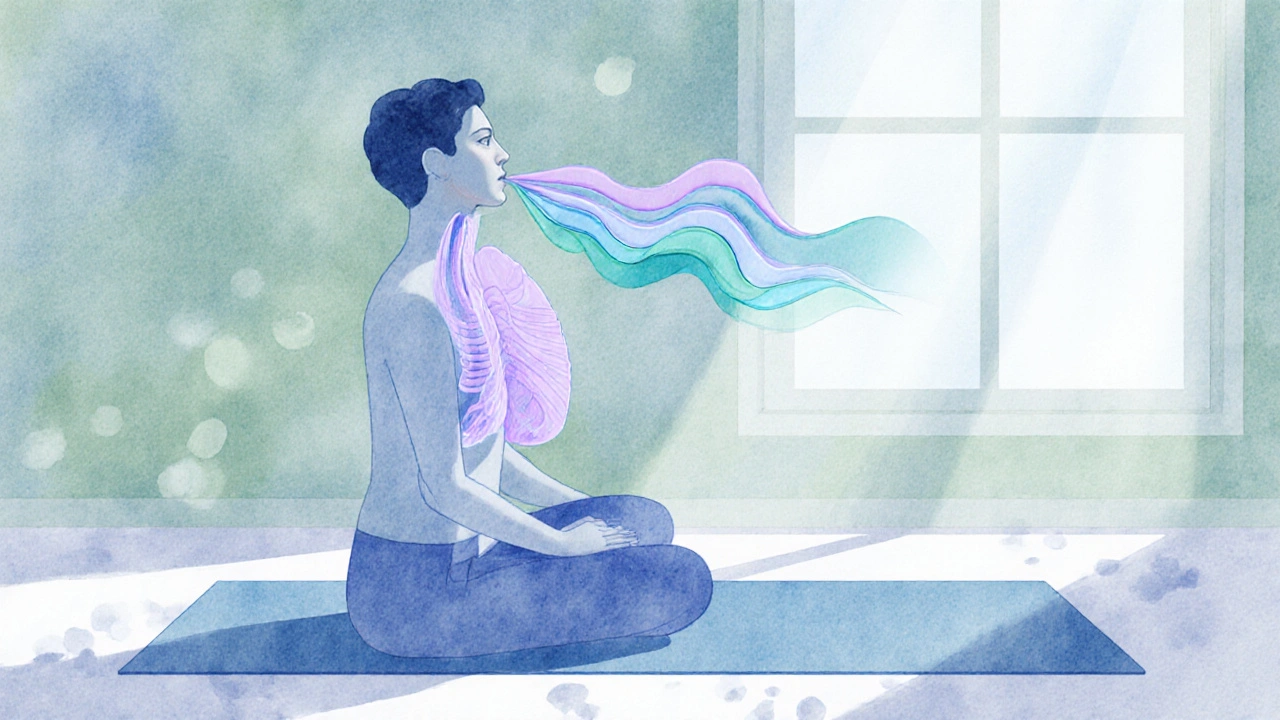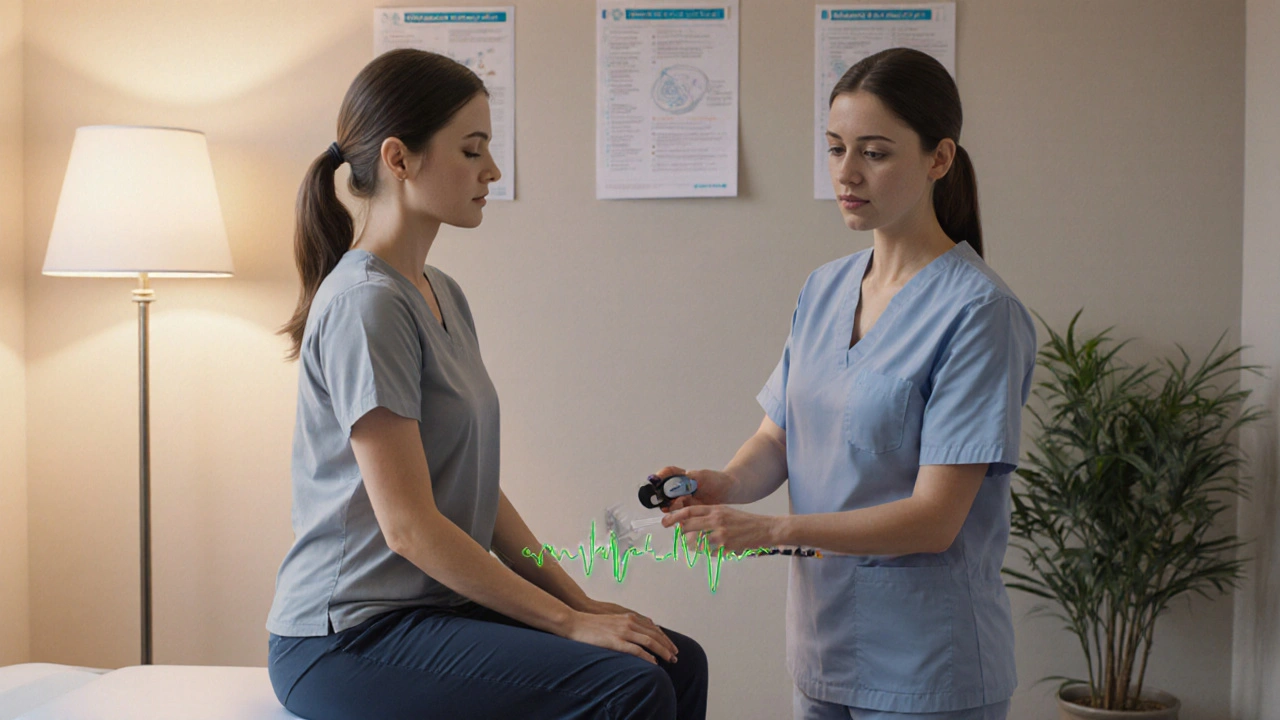How Stress Triggers Urine Leakage and Practical Ways to Stop It
 Oct, 5 2025
Oct, 5 2025
Stress & Urine Leakage Tracker
How Stress Affects Your Bladder
Stress can increase bladder pressure and tighten pelvic muscles, leading to urine leakage. Track your symptoms to identify triggers.
Your Stress & Leakage Analysis
Enter your information and click "Analyze My Stress Pattern" to see personalized insights.
Quick Takeaways
- Stress can worsen or even cause urine leakage by tightening pelvic muscles and raising bladder pressure.
- Identifying stress‑related triggers helps you target the right treatment.
- Mind‑body techniques (deep breathing, meditation) reduce cortisol spikes that irritate the bladder.
- Consistent pelvic floor workouts, like Kegels, restore muscle balance.
- When lifestyle changes aren’t enough, a urologist or pelvic‑floor physio can offer tailored therapies.
Understanding Stress‑Related Urine Leakage
When urinary incontinence refers to the involuntary loss of urine and you notice it spikes during a hectic workday or after a stressful meeting, you’re likely dealing with a stress component. Stress isn’t just “being nervous.” It’s a cascade of hormones-primarily cortisol and adrenaline-that tighten muscles, increase heart rate, and raise blood pressure. Those same physiological shifts can press on the bladder and pelvic floor, making a leak more probable.
While urinary incontinence is the umbrella term, the specific form most tied to stress is called stress urinary incontinence (SUI). SUI occurs when physical pressure (coughing, sneezing, lifting) overcomes a weakened pelvic floor. Chronic emotional stress can mimic that pressure from the inside out.
How Stress Affects the Bladder and Pelvic Floor
Stress is the body’s response to perceived threats, releasing cortisol and adrenaline works like a double‑edged sword for the urinary system:
- Muscle tension: Cortisol signals the skeletal muscles to tighten. The pelvic floor muscles are no exception; they become overly contracted, losing the coordinated relaxation needed during voiding.
- Increased abdominal pressure: Adrenaline raises heart rate and can cause shallow, rapid breathing. This pattern often leads to inadvertent Valsalva maneuvers (holding breath while straining), pushing the bladder upward.
- Bladder hypersensitivity: High cortisol levels can irritate the bladder lining, lowering the threshold for the urge to void.
Over time, these effects wear down the supportive tissue, especially in women after childbirth or men with prostate issues, but anyone under chronic stress can experience them.

Identifying When Stress Is the Culprit
Pinpointing stress as the trigger involves a bit of detective work:
- Pattern tracking: Keep a diary for two weeks. Note moments of anxiety, caffeine spikes, or heavy workloads alongside any leakage episodes.
- Physical cues: Tightness in the hips, lower back, or a “knotted” feeling in the pelvic area often precedes a leak.
- Symptom timing: Leaks that happen primarily during stressful events (presentation, exam, argument) suggest a stress link rather than a purely mechanical cause.
If you see a clear correlation, you’ve got a solid case for stress‑focused management.
Managing Stress to Reduce Leakage
Stress management isn’t a one‑size‑fits‑all, but a combination of proven tools can calm the hormonal surge that unsettles your bladder.
- Deep diaphragmatic breathing: Inhale through the nose for four counts, let the belly expand, then exhale slowly for six counts. This simple rhythm lowers cortisol within minutes.
- Progressive muscle relaxation (PMR): Starting at the toes, tense each muscle group for five seconds, then release. Include the pelvic floor by gently squeezing the muscles you’d use to stop urine flow.
- Mindfulness meditation: A daily 10‑minute session using apps or guided audio trains the brain to respond less aggressively to stressors.
- Cognitive‑behavioral techniques: Reframe stressful thoughts (“I can’t handle this”) into actionable plans (“I’ll take a five‑minute break”).
- Regular physical activity: Moderate cardio (walking, cycling) improves circulation to the pelvic region and reduces overall stress hormones.
Consistency is key. Even a short, daily practice can lower baseline cortisol by up to 20% according to a 2023 clinical trial.
Strengthening the Pelvic Floor
When stress is under control but leakage persists, the pelvic floor often needs rebuilding.
- Kegel exercises: Identify the correct muscles by stopping urine flow mid‑stream. Perform three sets of 10 slow squeezes (hold 5seconds) followed by 10 quick pulses. Aim for daily sessions.
- Biofeedback training: Devices with built‑in sensors give real‑time visual feedback, helping you fine‑tune contraction strength and timing.
- Pelvic‑floor physical therapy: A certified therapist can teach advanced techniques, such as resisted hip‑abduction and functional integration during daily activities.
Research from the International Urogynecological Association (2022) shows that a 12‑week Kegel program reduces stress‑related leakage episodes by 40% on average.

Lifestyle Tweaks That Support Bladder Control
Small daily habits can make a big difference alongside stress and muscle work.
| Factor | Impact on Bladder | Practical Adjustment |
|---|---|---|
| Caffeine | Increases urine production and irritates bladder lining | Limit to 1‑2 cups/day; switch to herbal tea |
| Fluid Timing | d>Large volumes before bedtime raise nocturnal urgencySpread intake evenly; stop drinking 2hours before sleep | |
| Weight Management | Extra abdominal weight raises intra‑abdominal pressure | Aim for a BMI <25; incorporate strength training |
| Smoking | Nicotine irritates the bladder and weakens connective tissue | Seek cessation resources; nicotine patches reduce cravings |
| Clothing | Tight waistbands compress the pelvic region | Choose loose‑fit sit‑ups and breathable fabrics |
These tweaks don’t replace pelvic‑floor work, but they remove added pressure that can sabotage your progress.
When to Seek Professional Help
If you’ve tried stress reduction, pelvic‑floor exercises, and lifestyle changes for at least eight weeks and leaks still interfere with work or social life, it’s time to consult a specialist.
- Urologist or urogynecologist: Can run urodynamic tests to assess bladder pressure and rule out infections.
- Medication options: Anticholinergics (e.g., oxybutynin) or beta‑3 agonists (mirabegron) may calm an overactive bladder that’s aggravated by stress.
- Surgical interventions: Mid‑urethral slings or bulking agents are considered when conservative measures fail.
Remember, surgery is a last resort. Most patients achieve satisfactory control with a combined approach of stress management and muscle training.
Frequently Asked Questions
Can stress alone cause urine leakage?
Yes. Chronic stress raises cortisol and adrenaline, which tighten the pelvic floor and increase abdominal pressure, creating conditions ripe for stress urinary incontinence.
How long does it take to see results from Kegel exercises?
Most people notice a reduction in leakage after four to six weeks of consistent practice, with optimal results around three months.
Are there any foods that worsen stress‑related leakage?
Spicy foods, carbonated drinks, and excess citrus can irritate the bladder. Pair them with plenty of water to dilute the effect.
Should I stop all caffeine if I have stress urinary incontinence?
You don’t need to quit completely, but limiting intake to one or two cups a day reduces bladder stimulation without sacrificing enjoyment.
Is medication necessary for stress‑related leakage?
Medication is usually reserved for cases where the bladder is also overactive. For pure stress leakage, lifestyle and pelvic‑floor training are first‑line treatments.
Mr. Zadé Moore
October 5, 2025 AT 18:51Your post reduces a complex neuro‑urological feedback loop to a simplistic checklist, which is intellectually negligent. The reductionist framing betrays a lack of methodological rigor.
Brooke Bevins
October 5, 2025 AT 20:14Hey, I totally get how stressful moments can make your bladder feel like a rogue sprinkler, and that's genuinely frustrating 😅. Taking a few minutes for deep breathing can really recalibrate the nervous system and give you some relief.
Vandita Shukla
October 5, 2025 AT 21:37Allow me to interject: the correlation between cortisol spikes and detrusor overactivity is well‑documented in peer‑reviewed literature, so the suggestion to “just drink water” is overly simplistic and ignores the endocrine dimension.
Tom Saa
October 6, 2025 AT 00:24Stress, in its physiological guise, operates as a cascade of catecholaminergic surges that modulate both central and peripheral organ systems. When the hypothalamic‑pituitary‑adrenal axis is activated, the bladder’s smooth muscle receives heightened adrenergic input, which can paradoxically increase urgency. Moreover, the insular cortex, responsible for interoceptive awareness, becomes hypervigilant under stress, amplifying perceived bladder signals. This neuro‑visceral dialogue is not merely anecdotal; it is substantiated by functional MRI studies that reveal heightened activation patterns during stress‑induced urgency. Consequently, the urinary leakage you experience is not a moral failing but a somatic expression of chronic psychosomatic feedback loops. To mitigate this, one must adopt a multidimensional approach that addresses both mind and muscle. Begin by instituting diaphragmatic breathing exercises for five minutes each morning, thereby attenuating sympathetic dominance. Concurrently, engage in progressive muscle relaxation, focusing on the pelvic floor to restore its tone. Regular pelvic floor physiotherapy, such as biofeedback‑guided Kegel drills, reinforces neuromuscular coordination. It is also advisable to maintain a stress diary, noting triggers, intensity, and leakage episodes, which can illuminate patterns invisible to conscious recall. Nutritional adjustments, like reducing caffeine and sugary drinks, alleviate bladder irritability and support endocrine balance. Gentle aerobic activity, such as brisk walking, stimulates endorphin release, which counteracts cortisol elevation. Meditation, even in brief ten‑minute sessions, has been shown to lower basal cortisol levels, offering a protective buffer for the bladder. Finally, consider consulting a urologist who can assess underlying functional disorders that may be exacerbated by stress. By integrating these strategies, you forge a resilient interface between the psyche and the pelvic organs, reducing the incidence of involuntary leakage. Remember, the journey is incremental; consistency trumps intensity in the long run.
Andrea Mathias
October 6, 2025 AT 03:11Listen up, folks-stress‑induced leaks are nothing short of a betrayal by our own bodies, a silent sabotage that our patriotism can’t ignore. The solution? Tough love: cut the caffeine, ditch the late‑night Netflix marathons, and command your pelvic floor like a drill sergeant. When you treat your bladder with the same discipline you’d demand of a soldier, the leaks will cease to be the embarrassing covert operation they currently are.
TRICIA TUCKER
October 6, 2025 AT 05:57Hey everyone! Just a quick reminder to watch your verb tenses when you’re describing past stress episodes-keep it consistent for clarity. Also, using inclusive language like “people who experience leakage” helps everyone feel welcome. If you need a hand with editing, I’m happy to hop in!
Dave Tu
October 6, 2025 AT 08:44While I appreciate the emphasis on stress management, the claim that “deep breathing alone can stop urine leakage” lacks empirical support and oversimplifies a multifactorial condition. A more rigorous approach would involve reviewing urodynamic studies before making such definitive statements.
Johnna Sutton
October 6, 2025 AT 11:31It is absolutely clear that the mainstream medical narrative is being suppressed by a shadowy cabal of pharmaceutical interests, which is why we are never told the truth about natural remedies for stress‑induced incontinence. The only way to break free from this indoctrination is to adopt ancient herbal protocols that have been definitively proven to work-definately.
Sam Rail
October 6, 2025 AT 14:17Totally get it.
Christine Watson
October 6, 2025 AT 17:04Hang in there, Sam! You’re not alone, and taking small steps like tracking triggers can make a huge difference. Keep at it-you’ve got this! 😊
Macy Weaver
October 6, 2025 AT 19:51Thanks for sharing your experience, Brooke. It’s valuable to hear how simple breathing exercises helped you manage stress‑related leaks, and I think adding a brief mindfulness routine could amplify those benefits for many of us.